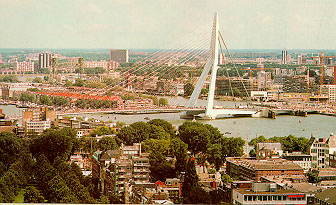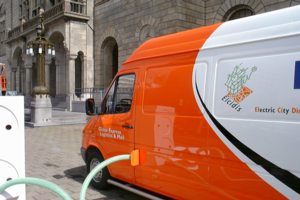
 ELCIDIS: Rotterdam
ELCIDIS: Rotterdam
 Rotterdam, with about
600 000 inhabitants, has one of the largest ports in the world and is therefore
the central mainport for goods distribution in Europe. Rotterdam's transport
policy aims at facilitating the economically important distribution activities
whilst reducing the environmental impact of traffic. To achieve this objective,
goods transport is being shifted towards environmentally-friendly transport
by rail and water. However, trains and ships only offer an alternative for
long-distance transport, not for regional transport and urban distribution
activities. Goods distribution in Rotterdam is and will be, in the near
future, based on road transport.The best way of solving the problems of
urban distribution in Rotterdam, is by evolving road transport in the city
into a clean and efficient urban distribution system.
Rotterdam, with about
600 000 inhabitants, has one of the largest ports in the world and is therefore
the central mainport for goods distribution in Europe. Rotterdam's transport
policy aims at facilitating the economically important distribution activities
whilst reducing the environmental impact of traffic. To achieve this objective,
goods transport is being shifted towards environmentally-friendly transport
by rail and water. However, trains and ships only offer an alternative for
long-distance transport, not for regional transport and urban distribution
activities. Goods distribution in Rotterdam is and will be, in the near
future, based on road transport.The best way of solving the problems of
urban distribution in Rotterdam, is by evolving road transport in the city
into a clean and efficient urban distribution system.
 In Rotterdam the three main transport companies
are already active as urban distributors. These companies, transporting
about 70% of all parcels & packages, operate from their central distribution
centres situated at the edge of the city.The companies use large trucks
for long-distance transport to the distribution centres and distribute
goods in and out of the city by vans and small trucks. In this efficiently
organised urban distribution system a further reduction in the emissions
of noise and air pollution must be reached by introducing cleaner vehicles.
Electric vehicles offer a clean alternative to the diesel engine vehicles
and are very suitable for the short trips and many stops characteristic
of urban distribution vehicles. Furthermore, these vehicles will be more
energy-efficient.
In Rotterdam the three main transport companies
are already active as urban distributors. These companies, transporting
about 70% of all parcels & packages, operate from their central distribution
centres situated at the edge of the city.The companies use large trucks
for long-distance transport to the distribution centres and distribute
goods in and out of the city by vans and small trucks. In this efficiently
organised urban distribution system a further reduction in the emissions
of noise and air pollution must be reached by introducing cleaner vehicles.
Electric vehicles offer a clean alternative to the diesel engine vehicles
and are very suitable for the short trips and many stops characteristic
of urban distribution vehicles. Furthermore, these vehicles will be more
energy-efficient.
 ELCIDIS offers
Rotterdam the possibility of introducing 9 electric vehicles for deliveries
of parcels & packages for the three participating transport companies.
The vehicles must prove themselves in the existing logistic systems of
these companies. A vehicle serves up to a hundred addresses a day in one
single trip, which demands a payload of 1000 - 1500 kg.These type of electric
vehicles are not yet been widely tested in practice, which means that
this project offers a unique opportunity for doing so. Furthermore, the
possibility of less restrictions in the city centre for these electric
delivery vehicles will be integrated in the project.
ELCIDIS offers
Rotterdam the possibility of introducing 9 electric vehicles for deliveries
of parcels & packages for the three participating transport companies.
The vehicles must prove themselves in the existing logistic systems of
these companies. A vehicle serves up to a hundred addresses a day in one
single trip, which demands a payload of 1000 - 1500 kg.These type of electric
vehicles are not yet been widely tested in practice, which means that
this project offers a unique opportunity for doing so. Furthermore, the
possibility of less restrictions in the city centre for these electric
delivery vehicles will be integrated in the project.
|
Co-ordinator for the Rotterdam project: Ton Vermie Phone + 31 10 489 6185 |